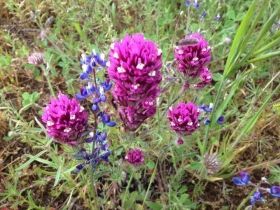Native wildflowers were surprisingly resilient during California’s most recent drought, even more so than exotic grasses. But signs of their resilience were not evident with showy blooms aboveground. Rather, they were found mostly underground, hidden in the seed bank, according to a study from the University of California, Davis.
For the study, published March 1 in the journal Ecology, researchers analyzed more than 22,000 seedlings from soil cores collected at UC’s McLaughlin Natural Reserve in Northern California during the fall of 2012 and 2014. They found that seeds from native wildflowers increased 201 percent underground, while aboveground growth increased 14 percent.
Meanwhile, seeds from exotic grasses decreased 52 percent belowground, while aboveground growth decreased 39 percent.
“Even wildflowers that are considered intolerant to drought appeared resilient to a single extreme drought event,” said lead author Marina LaForgia, a graduate student in the lab of professors Susan Harrison and Andrew Latimer in the UC Davis Department of Plant Sciences. “However, more frequent, severe or prolonged future droughts could eventually exceed these native species’ capacity to put more and more seeds into the seed bank for their long-term survival.”
Read more at University of California - Davis
Image: California wildflowers, such as these miniature lupine and denseflower Indian paintbrush flowers, were more resilient to the recent drought than they may have appeared. (Credit: Marina LaForgia/UC Davis)


